|
Rough
Terrain Fork Lift Safety [
back to top ]
1-2 Day Program
Meeting and Surpassing all OSHA & ASME requirements
ASME
B56.6-1994 states, "The use of powered and non-powered
industrial trucks is subject to certain hazards that cannot
be completely eliminated by mechanical means, but the risks
can be minimized by the exercise of intelligence, care,
and common sense. It is therefore essential to have competent
and careful operators, physically and mentally fit, and
thoroughly trained in the safe operation of the equipment
and handling of the loads." You can be confident of
your employees' abilities upon their completion of this
course.
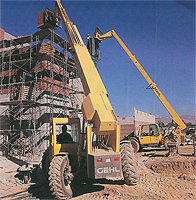
Regulations
and Standards Referenced
OSHA
1926.602 - Material Handling Equipment
ASME B56.6 - Rough Terrain Fork Lift Trucks
Topics
and Subject Matter Covered
| |
Operator
Responsibilities |
| |
Accident
Analysis |
| |
Required
Inspection Documentation |
| |
Daily
Inspection Procedures |
| |
Operational
Considerations |
| |
Rated
Capacities of Attachments / Different Configurations |
| |
Understanding
Load / Capacity Charts |
| |
Proper
Truck Selection |
| |
Proper
Driving with the Load |
| |
Operator
Do's and Don'ts |
| |
Load
Placement |
| |
Safeguarding
the Truck |
| |
Accident
Prevention |
Industrial
Lift Trucks [
back to top ]
1-2 Day Program
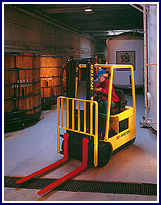 Powered
industrial lift trucks, also more commonly known as fork
trucks, are the most popular type of material-handling machinery
in use today. It is a common perception that due to design
and operating characteristics of this type of machine, anyone
is able to operate it with little or no training. Accident
statistics prove this to be a misconception. The trainee
and/or experienced operator will benefit from this program. Powered
industrial lift trucks, also more commonly known as fork
trucks, are the most popular type of material-handling machinery
in use today. It is a common perception that due to design
and operating characteristics of this type of machine, anyone
is able to operate it with little or no training. Accident
statistics prove this to be a misconception. The trainee
and/or experienced operator will benefit from this program.
Regulations
and Standards Referenced
OSHA 1910.178
- Powered Industrial Trucks
ASME B56.1 - Low Lift and High Lift Trucks
Topics
and Subject Matter Covered
| |
Operator
Responsibilities |
| |
Daily
Inspection & Required Documentation |
| |
Visual/Operational
Checks |
| |
Pedestrian
Traffic & Safety |
| |
Rated
Capacities at Different Configurations |
| |
Rated
Capacities of Attachments |
| |
Hazardous
Classified Locations |
| |
Picking
the Load |
| |
Steering
& Maneuvering |
| |
Operating
Instructions, Warnings & Precautions |
| |
Load
Manipulation & Unstacking |
| |
Safeguarding
the Truck |
| |
Accident
Prevention |
 |
Similarities
& Differences from an Automobile |
Aerial
Lift Safety [
back to top ]
1 Day Program
Covering all types of Work Platforms
Approximately
75% of accidents with aerial lifts were caused by operator
error. Through this program the operator will learn principles
of safe operation, how to avoid potential accidents, and
industry requirements for aerial lift safety.

Regulations
and Standards Referenced
OSHA
1910.67 - Vehicle-Mounted Elevating Work Platforms
OSHA 1926.556 - Aerial Lifts
ASME / SIA A92.2 - Vehicle Mounted Elevating & Rotating
Aerial Devices
ASME / SIA A92.3 - Manually Propelled Elevating Aerial
Platforms
ASME / SIA A92.5 - Boom Supported Elevating Work Platforms
ASME / SIA A92.6 - Self-Propelled Elevating Work Platforms
Topics
and Subject Matter Covered
| |
Operator
/ User's Responsibility |
| |
Operator's
Manual Types, Components and Terminology |
| |
Accident
Prevention |
| |
Pre-Start
Considerations Proper Set-Up |
| |
Principles
of Operation |
| |
Safe
Operating Procedures |
| |
Traveling
the Aerial Lift |
| |
Operating
Near Electrical Equipment |
| |
Load
Testing |
| |
Preventive
Maintenance |
Aerial
Lift Inspector [
back to top ]
1 Day Program
Covering the dynamics of a thorough inspection
Through
this training you will learn the vital components of a thorough
inspection which will enable you to perform in-house inspections
to comply with OSHA and ASME / SIA daily, periodic, and
annual inspections requirements.
Regulations
and Standards Referenced
OSHA
1910.67 - Vehicle-Mounted Elevating Work Platforms
OSHA 1926.556 - Aerial Lifts
ASME / SIA A92.2 - Vehicle Mounted Elevating & Rotating
Aerial Devices
ASME / SIA A92.3 - Manually Propelled Elevating Aerial
Platforms
ASME / SIA A92.5 - Boom Supported Elevating Work Platforms
ASME / SIA A92.6 - Self-Propelled Elevating Work Platforms
Topics
and Subject Matter Covered
| |
Types,
Components and Terminology |
| |
Inspector
Responsibilities |
| |
Inspector
Qualifications |
| |
Inspection
Procedures, Checklists |
| |
Pre-Operational
Inspections |
| |
Stages
of Inspections |
| |
Accident
Prevention Through Proper Inspection |
| |
Preventive
Maintenance |
| |
Inspection
- Procedures, Checklist, and Record Keeping |
| |
Hands-on
Inspection and Instruction |
Train
the Trainer [
back to top ]
Length varies depending upon topic
Educating your Safety Trainer
Fall
Protection [
back to top ]
1 Day Program
Meeting newly required OSHA regulations
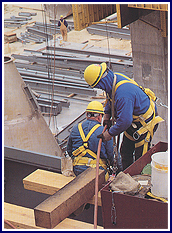 Recently,
OSHA revised its fall protection standards to include some
very specific rules regarding use, adequacy and training.
Fall protection standards became effective February 16,
1995 on the Federal level, and April 6, 1995 for state-run
programs. This program covers all the new OSHA guidelines
and will familiarize your employees with the principles
of fall protection and fall protection systems. Recently,
OSHA revised its fall protection standards to include some
very specific rules regarding use, adequacy and training.
Fall protection standards became effective February 16,
1995 on the Federal level, and April 6, 1995 for state-run
programs. This program covers all the new OSHA guidelines
and will familiarize your employees with the principles
of fall protection and fall protection systems.
Regulations
and Standards Referenced
OSHA
1926.500 - Fall Protection
OSHA 1926.501 - Duty to Have Fall Protection
OSHA 1926.502 - Fall Protection Criteria & Practices
OSHA 1926.503 - Training Requirements
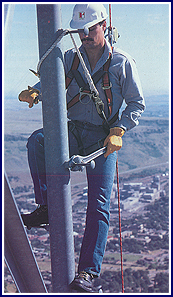 Topics
and Subject Matter Covered Topics
and Subject Matter Covered
| |
OSHA
Guidelines for Fall Protection |
| |
Difference
Between Slips, Trips, and Falls from Elevation |
| |
How
Falls Impact Company Dollars |
| |
Responsibilities
to Protect Workers |
| |
Recognizing
Potential Fall Hazards |
| |
Organizing
Fall Protection Programs on the Job |
| |
Understanding
Which Fall Protection Systems to Use |
| |
Proper
Maintenance and Inspection of Fall Arrest Systems |
| |
Fall
Arrest vs. Restraint |
Scaffold
Safety [
back to top ]
2 Day Class
Erection, Dismantling & Inspection
| INTRODUCTION |
|
|
Purpose |
|
|
|
Objectives |
|
|
|
Definitions |
|
|
PLANNING
THE JOB |
|
|
Personnel |
|
|
|
Job
Site Evaluation |
|
|
|
Scaffold
Rating |
|
|
|
Scaffold
Planks |
|
|
|
Component
Inspection |
|
|
SCAFFOLD
ERECTION SAFETY |
|
|
Personnel |
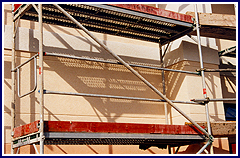 |
|
|
PPE |
|
|
Mud
Sills |
|
|
Base
Plates |
|
|
Scaffold
Base |
|
|
Secure
Scaffold |
|
|
Scaffold
Access |
|
|
Work
Platforms |
|
|
Falling
Object Protection |
|
|
Guardrails |
|
|
|
Mixing
Scaffold Components |
|
|
|
Inspection
Before Use |
|
|
SCAFFOLD
USE |
|
|
Electrical
Hazards |
|
|
|
Specific
Electrical Guidelines |
|
|
|
Arc
Welding and Cutting |
|
|
MATERIAL
HANDLING SAFETY |
|
|
Material
Handling Guidelines |
|
|
PROHIBITED
USER ACTIONS |
| SCAFFOLD
INSPECTIONS |
 |
Scaffold
Inspection Checklist |
|
| TECHNICAL
REFERENCES |
 |
Scaffold
Ties |
|
 |
Wind
Force |
 |
Wood
and Fabricated Planking |
 |
Frame
Scaffolds |
 |
Rolling
Tower Scaffolds |
 |
Tube
and Clamp Scaffolds |
| |
|
| STANDARDS
EXERCISES |
 |
OSHA
29CFR1926.451, 29CFR1926.454 and ANSI A10.8-2001 |
Articulating Boom Crane Operator [
back to top ]
2 Day Class
The Articulating Boom Crane Operator Training program is specifically designed to upgrade the existing knowledge and skill levels of experienced operators, trainees, safety personnel, inspectors, maintenance personnel, managers and supervisors. The information provided in the classroom is reinforced with hands-on application sessions on an articulating boom crane with equipment at your site. All personnel attending this program will gain significant and useful skills and will leave with a stronger understanding and appreciation of the requirements and responsibilities of Articulating Boom Crane Operators.
The Articulating Boom Crane Operator program provides an excellent learning environment for General Contractors, Railroad Maintenance, Roofers, Sign Erectors, Block and Brick Distributors, Municipalities, and Electrical Workers.
Regulations
and Standards Referenced
ASME B30.22 Articulating Boom Cranes
ASME B30.20 Below the Hook Lifting Devices
OSHA 1926.1400-1442 - Cranes and Derricks
OSHA 1910.180 - Crawler, Locomotive and Truck Cranes
Topics
and Subject Matter Covered
|
Operator Responsibilities |
|
Accident Prevention |
|
Proper Use of Hand and Voice Signals |
|
Applicable OSHA Regulations & ANSI/ASME Safety Standards |
|
Safe, Effective and Efficient Operating Techniques |
|
Proper Crane Set-up |
|
Evaluating Site Conditions |
|
Power Lines Awareness |
|
Ground Conditions and Supporting Surface Requirements |
|
Load Chart Interpretations and Applications |
|
Lift Planning & Determining and Verifying the Load Weight |
|
Below the Hook Lifting Devices (Forks, Clamps, etc.) |
|
Basic Rigging Principles |
|
Wire Rope Construction and Inspection |
|
Pre-Operation & Post Operation Inspections |
|

